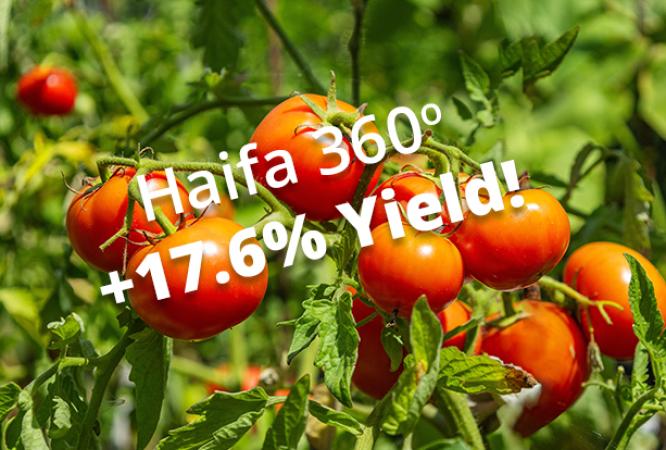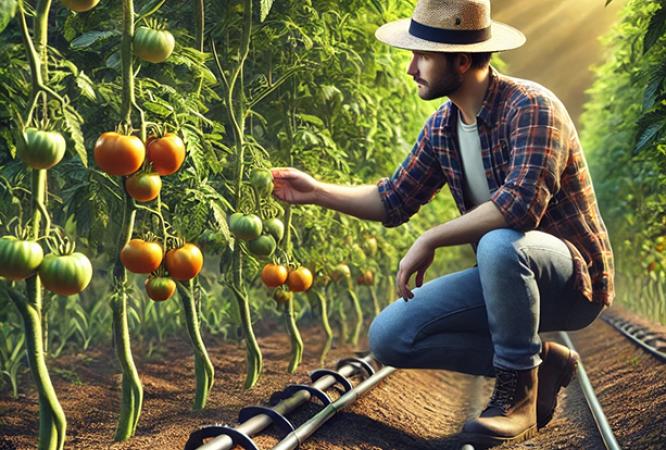Index:
Balanced irrigation & fertilization regime ensures optimal nutrition throughout the growth season.
Application of top-quality water-soluble fertilizers through the irrigation system is the optimal method for providing balanced plant nutrition throughout the growth season.
A balanced Nutrigation™ regime ensures that essential nutrients are placed precisely at the site of intensive root activity, and are available in exactly the right quantity when plants need them.
Evaporation considerations
The amount of water required per application can be determined by the coefficient of transpiration and the evaporation data from a class A pan. For example, average evaporation readings in the central part of Israel, expressed in mm/day, are given in table 26:
Table 26: Evaporation rates from Class A Pan in central Israel (mm/day)
Apr | May | Jun | Jul | Aug | Sep | Oct | Nov |
|---|---|---|---|---|---|---|---|
4.4 | 5.9 | 6.8 | 6.9 | 6.6 | 5.7 | 4.3 | 3.0 |
Plants, usually, are less influenced than an exposed pan to the prevailing climatic conditions, such as: sun, wind, humidity, etc., and will transpire less water. As an example, the percentage of transpiration by tomatoes, known as transpiration coefficient, is illustrated in Table 27. The coefficient increases according to the growth stage of the plant as the growing season evolves.
Table 27: Transpiration coefficients in tomatoes, according to the growth stages.
Growth stage | Planting –Blooming | Blooming – Fruit set | Fruit set - Harvesting |
|---|---|---|---|
Transpiration coefficient | 0.4 | 0.6 | 0.8 |
The following example of the amount of irrigation water, calculated from data collected on the losses of the evaporation A pan and multiplied by the transpiration coefficient is shown in Table 28.
Table 28: Example of water consumption of outdoor grown tomatoes, in Israel.
Growth stage | Month | Evaporation rates, (mm/day) | Transpiration coefficient | Water losses* (mm/day) | Required amount of irrigation water (m3 /ha/day) |
|---|---|---|---|---|---|
Blooming | May | 5.9 | 0.4 | 2.36 | 23.6 |
Fruit set | June | 6.8 | 0.6 | 4.08 | 40.8 |
Harvesting | July | 6.9 | 0.8 | 5.52 | 55.2 |
* - via transpiration.
If the irrigation cycle is not daily, then the daily amount has to be multiplied by the number of days between irrigation cycles as shown in Table 29.
Table 29: Example of required amount of water for out-door grown tomatoes.
Growth stage | Month | Amount of required irrigation per day (m3/ha) | Irrigation cycle(days) | Amount of water / irrigation per cycle (m3/ha) |
|---|---|---|---|---|
Blooming | May | 23.6 | 3 | 71 |
Fruit set | June | 40.8 | 5 | 204 |
Harvesting | July | 55.2 | 4 | 222 |
2. Tomato crop guide: Appendix II: Plant analysis guide
Nutrient Sufficiency Ranges
(source: A & L, Agronomy Handbook, Ankerman & Large, Eds.)
(source: A & L, Agronomy Handbook, Ankerman & Large, Eds.)
| N | P | K | Mg | Ca | S | Na | B | Zn | Mn | Fe | Cu | Al | |
|---|---|---|---|---|---|---|---|---|---|---|---|---|---|
| % | ppm | ||||||||||||
| From | 3.00 | 0.30 | 2.5 | 0.5 | 2.00 | 0.5 | 0.01 | 40 | 35 | 100 | 100 | 8 | 20 |
| To | 6.00 | 0.80 | 5.00 | 1.00 | 6.00 | 0.9 | 0.01 | 60 | 50 | 200 | 200 | 20 | 200 |
Plant sampling
| Growth stage | Plant part to sample | No. of plants or leaves to sample | |
|---|---|---|---|
| Open-field tomatoes | Prior to or during early bloom stage | 3rd or 4th leaf from growing tip | 20-25 |
| Greenhouse tomatoes | Prior to or during fruit-set | Young plants: leaves adjacent to 2ndor 3rd cluster | 20-25 |
| Older plants: leaves from 4th to 6thclusters | 20-25 |
Need more information about how to grow tomato? You can always return to the tomato fertilizer & tomato crop guide table of contents or the tomato plant stages






